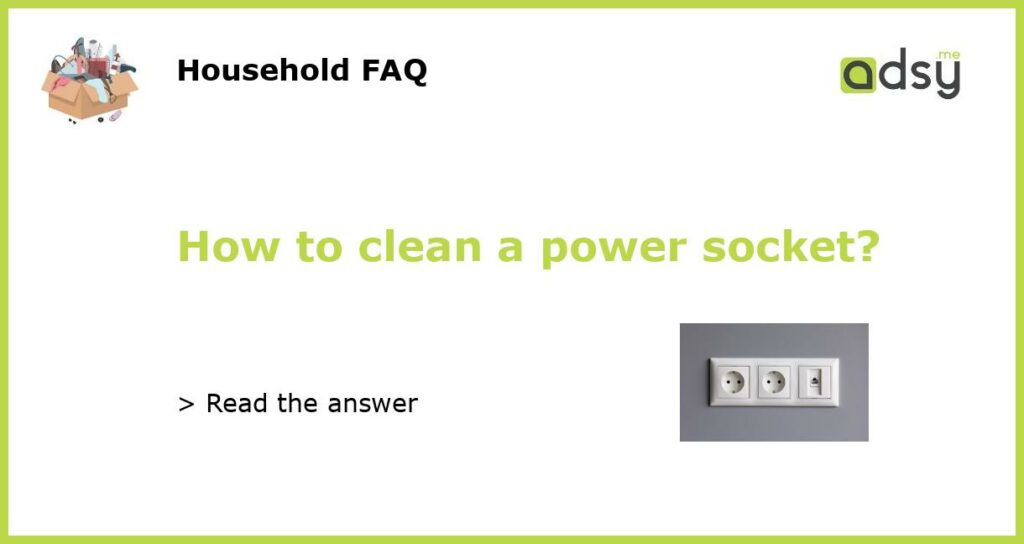Understanding the Importance of Cleaning Power Sockets
Power sockets are an essential part of our everyday lives. They provide electricity to power our devices and appliances, ensuring that we can live comfortably and conveniently. However, over time, power sockets can become dirty and dusty, leading to a decrease in their performance and potentially posing a safety hazard. That is why it is important to regularly clean power sockets to maintain their functionality and prevent any issues.
Gathering the Required Tools and Materials
Before you start cleaning your power sockets, it is important to gather the necessary tools and materials. The following items will be needed:
- A soft cloth or microfiber cloth
- A small brush or toothbrush
- Cotton swabs or cotton balls
- Rubbing alcohol or a mild cleaning solution
- A screwdriver (if necessary)
Steps to Clean Power Sockets Safely
Here are the steps to clean power sockets safely:
- Turn off the power: Before you start cleaning, make sure to turn off the power to the socket you will be cleaning. This can be done by switching off the corresponding circuit breaker at the main electrical panel.
- Remove the socket cover (if applicable): Some power sockets have a removable cover. Use a screwdriver to remove the cover carefully.
- Dust the socket: Use a soft cloth or microfiber cloth to gently wipe away any dust or debris from the socket. Be careful not to use excessive force or apply pressure to the socket.
- Clean the socket openings: Use a small brush or toothbrush to carefully clean the openings of the socket. This will remove any dirt or dust that may have accumulated.
- Use cotton swabs for stubborn dirt: If there is stubborn dirt or grime in the socket, moisten a cotton swab or cotton ball with rubbing alcohol or a mild cleaning solution. Use this to carefully clean the inside of the socket.
Safety Precautions When Cleaning Power Sockets
While cleaning power sockets, it is crucial to follow some safety precautions to prevent any accidents or injuries:
- Turn off the power: Always remember to turn off the power to the socket you are cleaning before starting the cleaning process. This will minimize the risk of electric shock.
- Avoid using water: As power sockets involve electricity, it is important to avoid using water or any other liquid while cleaning them. Instead, use a damp cloth or a cleaning solution that is safe for electrical components.
- Do not use abrasive materials: Avoid using abrasive materials, such as steel wool or harsh brushes, as they can damage the socket and cause electrical issues.
- Ensure the socket is dry before use: After cleaning, make sure that the socket is completely dry before using it again. This will prevent any moisture-related issues.
- Consult a professional if unsure: If you are unsure about cleaning power sockets or if you encounter any problems, it is advisable to consult a professional electrician who can provide guidance and assistance.
Maintaining Clean Power Sockets
Regular maintenance is key to keeping power sockets clean and functioning optimally. Here are some tips to help you maintain clean power sockets:
- Wipe them regularly: Use a soft cloth or microfiber cloth to wipe the power sockets regularly to minimize the accumulation of dust and dirt.
- Keep them covered: If possible, use socket covers to protect the power sockets from dust and debris when they are not in use.
- Inspect for any issues: Regularly inspect the power sockets for any signs of damage or wear and tear. If you notice any problems, such as loose connections or exposed wires, contact a professional electrician for repairs.
- Avoid overloading: Do not overload the power sockets by plugging in too many devices or appliances. This can put stress on the socket and increase the risk of electrical issues.
- Do not touch sockets with wet hands: Always make sure your hands are completely dry before touching any power sockets to minimize the risk of electric shock.






